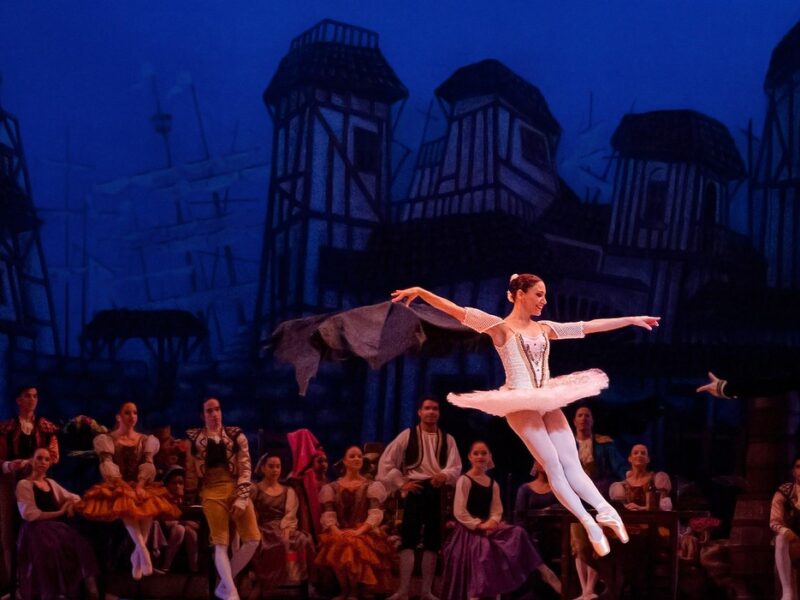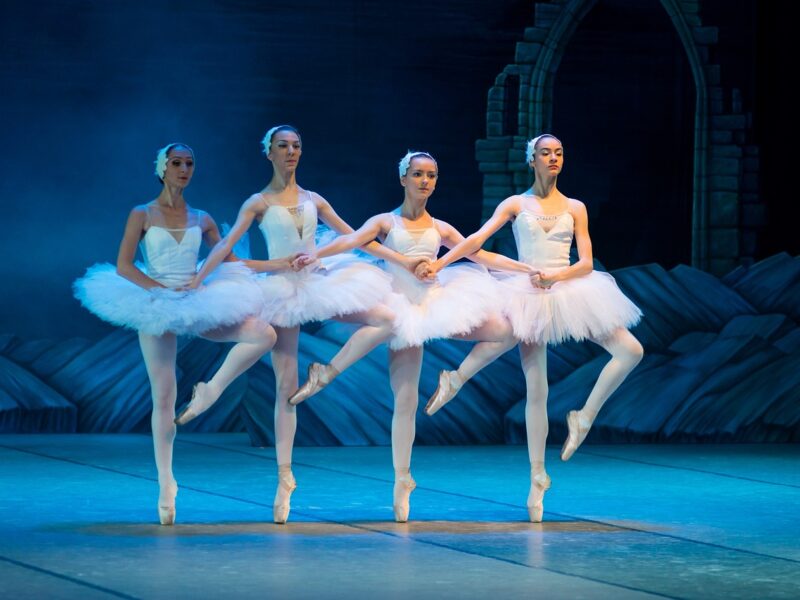I’ll be honest… I used to HATE turning. At my ballet peak I managed to get to a solid triple, but the real issue was that I didn’t understand why I was a ‘bad turner’, or how to improve so that I could spin, spin, spin like the ballerinas of Instagram. One day, back in school when I was 16, I remember sitting in a physics lesson and learning about rotational forces -torque, friction, moment of inertia… In that moment it all clicked: there was no way I could get better at turning if I didn’t understand the science behind pirouettes! After that the mission began, and here I am five years later, presenting my findings to teach YOU how to improve your pirouettes…
In this post, I’m going to explain the physics behind turning, whilst also providing some the best exercises you can do to spin harder, faster and stronger! What are you waiting for? Keep reading to find out how to improve your pirouettes today…
The head, spotting and proprioception
Okay, all dancers know that we need to spot when we’re turning, but few understand the science behind balance, spotting and proprioception, as well as how it can help us to improve our pirouettes…
Obviously spotting stops us from getting dizzy, but it also provides us with an orientation reference point (the front) which helps our brain to know where our body is in space in relation to this point. This has everything to do with a concept called PROPRIOCEPTION, or put simply, our brain’s ability know where our body is in space, as well as its ability to recognise and adapt to environmental changes and forces acting on the body.
To improve our pirouettes we need to develop the proprioceptive system. One of the best ways of doing this is by balancing on an unstable object (e.g. a cushion or bosu ball). When we do this, the external forces acting on our bodies require us to quickly adjust and stabilise ourselves to stay on balance.
This very much mimics the rotational forces (torque and friction) acting on the body when we pirouette, and helps our proprioceptive system to react to changes in momentum, speed and centre of mass to keep us on balance as we turn.
How to perform an airplane balance
Step 1) Start by standing on one leg
Step 2) Bend your standing leg and learn your torso forwards into a table-top position (keeping the back flat
Step 3) As you learn forwards, lift and extend your other leg behind you to create a horizontal line from head to toe. Your torso and back leg should be the same height off the ground
Step 4) Bring your arms out to the side of your torso (like aeroplane wings) and hold the balance
Top tip! In your pre-class warm up, try moving into the airplane balance from a standing position with your eyes closed and then repeat. This fun (yet tricky) exercise will wake up your proprioceptive system for better balance throughout the whole ballet class as well as in your pirouettes!
Tip for teachers: If you teach young students, you may notice that they find it difficult to execute or copy a position without looking down at their feet to check that they’re doing it properly. This is because their proprioceptive systems are still developing, meaning they often struggle to feel where their limbs are without looking at them (this is precisely why young children struggle to catch a ball and miss their mouths when they’re eating).
You can help to develop proprioceptive systems in young children with exercises such as the airplane balance or by playing catch. Another effective method is to ask children to execute a position (for example a tendu) and ask them to close their eyes and mentally ‘feel’ where their limbs are without looking at them.
Keep reading to find out how to improve your pirouettes using the muscles of the core…
The core muscles, rotation, anti-rotation and breathing
The deep core muscles…
Balancing in our pirouettes is all about alignment of the body, however it’s hard to achieve a stacked, vertical alignment whilst turning if your core is weak.
This need for the correct alignment comes down to a concept known as ‘the centre of mass’. Our centre of mass is the point in our body where all of our weight is focused. This tends to be around our belly button, and we need to keep this point (or centre) directly above the foot we are turning on if we want to stay balanced during pirouettes.
To do this, we need to imagine that our body is a long, solid plank of wood standing vertically… the wood doesn’t buckle or bend halfway up, and neither can we. In order to achieve this stability which will allow us to keep our centre of mass over our toes, we need to strengthen the deep muscles of our core…
The deep muscles of our core include the transversus abdominis, the internal and external obliques and the pelvic floor. Some of the best exercises you can do to strengthen these muscles include planks, Swiss ball pikes and toe taps.
TRX Saw Plank (one of my favourite plank variations)
Planks are one of the best ways to strengthen the deep muscles or the core… but let’s face it, they can be boring, right?
The TRX Saw Plank is a fun and challenging variation of the traditional plank, and if you don’t have access to TRX straps you can always prop your legs on a foam roller!
Step 1) Kneel and put your toes into the TRX foot cradles (or place a foam roller under your shins)
Step 2) Extend your body into a plank position on your forearms
Step 3) Keeping your core engaged and body aligned, rock backwards and forwards on your forearms as if your body is sawing through wood
Anti-rotation
Once again, during pirouettes we need to imagine that our body is a solid plank of wood – the plank turns as a whole, and the top half of the plank doesn’t rotate independently of the bottom half. This means that when we pirouette, we want our whole body to spin as a solid unit without the torso rotating separately to the legs… in other words, your shoulders must always be facing the same direction as your hips!
Our obliques are largely responsible for resisting the forces (such as torque or air resistance) which act on our body as we turn, and so strengthening our obliques can prevent our torso from over-rotating during pirouettes. If this rotation does occur, our body becomes misaligned, and we can fall out of our turns. Strengthening our core muscles using anti-rotation exercises will also help us to maintain control of our bodies during pirouettes, even in the face of external factors such as excessive momentum or an imbalanced centre of mass!
The majority of anti-rotation exercises involve strengthening the core (mainly the obliques) to resist a force which is trying to pull the torso into rotation.
Kneeling Pallof Press
The Pallof Press is a brilliant exercise for training the muscles of the core to resist rotation in our pirouettes. The forces of torque, friction and air resistance etc are mimicked when the cable wire or resistance band retracts and attempts to pull the torso into rotation. Your job is to use the core to resist this rotation!
If you’re using a cable machine, connect the stirrup handle for this exercise.
Step 1) Kneel down on one leg next to a cable machine or resistance band set at chest height (the height of your chest when kneeling). Position yourself perpendicular to the machine, with the leg you are kneeling on nearest to the machine.
Step 2) Set the cable machine to a low weight (to start with) and pull the stirrup handle to your chest
Step 3) Holding the handle with both hands, push it out in front of you without rotating your torso
Step 4) Bring the handle back into your chest and repeat
Rotation
We also need to practice rotational exercises to improve our pirouettes. Similar to anti-rotation, rotational exercises target the obliques (and other deep muscles of the core) which help to provide power and stability to the trunk during pirouettes.
Diagonal cable chop
This exercise can be performed using a cable machine or resistance band attached to the wall. You should position the cable wire/resistance band high up above your head. Use the stirrup handle attachment on the cable machine.
Step 1) Position yourself with your feet in a wide stance standing perpendicular to the cable machine (the machine should be to your side instead of in front of you)
Hold the stirrup handle with both hands and rotate your torso towards the cable machine.
Step 2) Engage your core and pull the stirrup handle down diagonally. You should twist your torso away from the cable machine as you do this
Step 3) Maintaining tension on the cable wire, return the stirrup handle to its starting position by rotating your torso towards the machine
Step 4) Repeat
Breathing
A lot of us instinctively hold our breath to help us balance (yes, I’m guilty of this too), however doing so will only leave us out of puff, and won’t aid our balancing skills very much at all!
During your pirouettes (and pretty much every other exercise in ballet), exhaling is actually incredibly effective at improving our ability to balance. This is because when we exhale whilst engaging the core (pulling the belly button towards the spine), we create something known as ‘intra-abdominal pressure’. This intra-abdominal pressure ‘switches on’ our deep core muscles, aiding in the stabilisation of our trunk and spine. This will improve balance in our pirouettes by helping us to maintain the stacked alignment we need to make sure our centre of mass stays above the ball of our foot.
Make sure to breath out as you relevé at the start of your pirouettes to create this intra-abdominal pressure!
Carry on reading to find out how to improve your pirouettes by strengthening your back muscles…
The arms and back
Our arms are important in our pirouettes for several reasons… not only do they stabilise us as we turn, but they also help to produce more torque and momentum which means we can spin faster and get round more times – in other words, your arms can really help you to get into the realm of very slick quadruples!
First let’s talk about stability… Keeping our arms in a small, solid first position in line with our belly button can help us to maintain balance when we turn. If we allow our arms to flap as we turn, we can easily lose balance and fall out of our turns. This stability in our arms comes from engagement in our latissimus dorsi muscles (or the lats) and we can activate these muscles in our turns by imagining that we are pushing our arms down in first position.
If you’re not sure whether you’re lacking stability or strength in your arms and back in your pirouettes, try turning whilst holding a solid object such as an umbrella, tennis racket or pilates ring between your hands in first position. If your turns are 100x times better, it probably means that you would benefit from strengthening your lats to improve stability in your arms during pirouettes!
Our arm movements in our preparation to pirouette also influence the quality of our turns. This has something to do with a force called ‘torque’ which causes an object to spin around a point, and another force known as the ‘moment of inertia’ which is the object’s resistance to spinning.
To make all of this physics a little bit easier to understand, I want you to image that you’re playing with a spinning top… when you spin the spinning top with your fingers, your fingers become the torque force which is making the object rotate. However, the frictional force acting on the spinning top from the table’s surface creates the moment of inertia, as this friction slows the object down and creates resistance.

If none of that makes sense, please don’t worry about it! All you need to know is that when we first start our pirouette, we use our arms to create torque and momentum to help us turn. We do this by first opening the leading arm and then bringing the second arm in to a tight first position. Doing this lowers or counteracts the moment of inertia we experience from the forces of air resistance and friction from the floor as our foot turns on it.
Basically… lots of torque + little moment of inertia = more turns
This movement of our arms need to happen quickly and concisely if we want to produce the level of torque and momentum needed to perform several pirouettes. Once again, this requires power and strength from our lats (amongst other muscles in our back and shoulders).
Lat rows
Lat rows are one of the best exercises which target the latissimus dorsi muscles to achieve stability in the arms as we turn.
For this exercise, you should use the cable machine with the tricep rope attachment at the lowest height. Alternatively, your can wrap a resistance band around your feet and hold it at both ends.
Step 1) Sit facing the cable machine with your legs straight out in front of you. Hold the tricep rope (or resistance band) with both hands
Step 2) Pull the tricep rope towards you keeping your elbows low and arms by your side. You should keep pulling until your elbows reach behind you
Step 3) Slowly extend your arms to the starting position and repeat
Pilates ring press down
This exercise is great because you’re required to press down on an object to activate your lats. This will help you to engage these muscles during your pirouettes as you press down in your first position.
Step 1) Sit down and position a pilates ring in front of your left arm
Step 2) Keeping you shoulders down, use your hand to press down on the ring. You should feel muscle engagement in your lats
Step 3) Repeat using the right arm
The legs and glutes
A lot of dancers think that upper body strength creates quality turns. Although this is the case, we do also need strength in our legs, hips and glutes to achieve hip stability, a high passé and a strong relevé in our pirouettes!
Keep reading to learn how to improve your pirouettes by strengthening the hips, glutes, calves and hamstrings…
Hip Stability
During our pirouettes we place our weight through the leg we are turning on. If we are lacking in glute and hip strength, we are likely to sit into the hip of our standing leg. This creates misalignment of the hips, which shifts our centre of mass and causes us to lose balance and fall out of our turns.
The best exercise to improve hip and glute strength and stability is the bird-dog.
Relevé
When starting our pirouette, we need to make sure that our relevé to passé happens quickly. If we are still making our way up to full height in our relevé when we have already started turning, it’s going to be very difficult to stay on balance.
You can improve the speed and strength of your relevés by performing calf raises.
If calf raises become too boring, you can increase the challenge and mimic the relevé action in our pirouettes by first lunging and then quickly straightening the front leg and bringing the back leg up to a turned in passé en relevé. This will also test your balance and help to improve proprioception!
The hamstrings and glutes
To improve our pirouettes we need to keep our working leg in a high passé. Doing so helps to keep our hips aligned which aids our balance by keeping our centre of mass over the foot of our standing leg.
Strengthening the hamstrings and glutes will help us to achieve a high, turned out passé in our turns. This turn out is actually really important for our pirouettes en dehors, where you should visualise the lateral (external) side of the knee leading the turn to help you get round.
You can improve hamstring and glute strength by performing frog lifts…
Step 1) Lie on your belly with your arms bent and hands under your forehead
Step 2) Create a ‘frog’s legs’ position by bending and opening your legs whilst lifting your shins off the floor. Your feet should be flexed and turned out
Step 3) Squeeze your glutes to lift your thighs off the floor
Final thoughts on How To Improve Your Pirouettes; The Science Behind Turning
I love teaching students how to pirouette, mainly because explaining the abundance of physics behind the movement can help dancers to really UNDERSTAND how they can improve their turns.
Strengthening our muscles and getting to grips with proprioception is far better practice for achieving stronger pirouettes than spinning over and over again on the kitchen floor every night (hint… this will only make you super dizzy)!
If you’ve loved this article exploring how to improve your pirouettes, go check out TheBalletDoctor on Instagram for more of the best technique and cross-training tips and tricks. See you there, dancers!
**FRIENDLY DISCLAIMER: All information, guidance or advice provided on this site is for informational and educational purposes only. The use of this information is at your own risk. **

